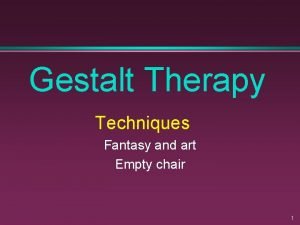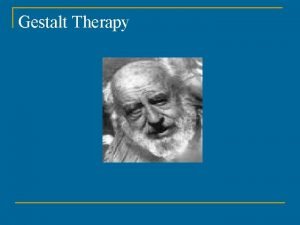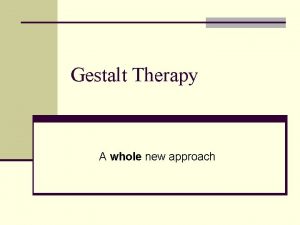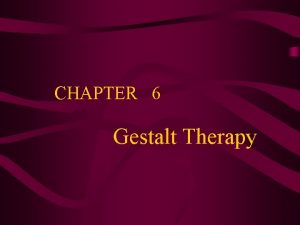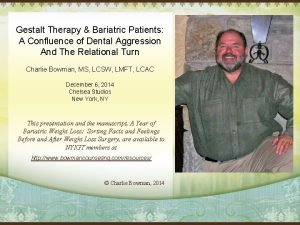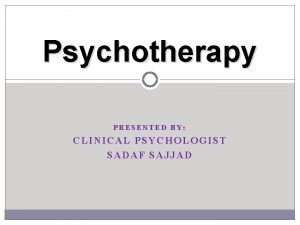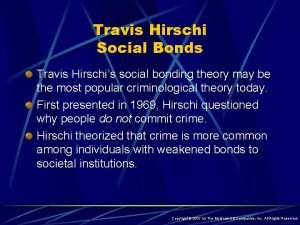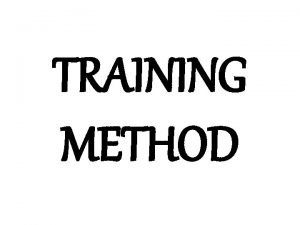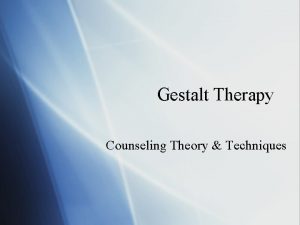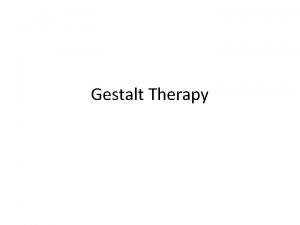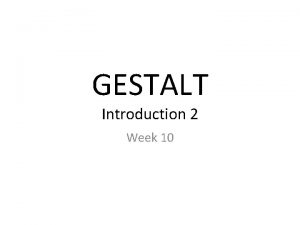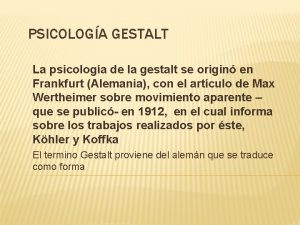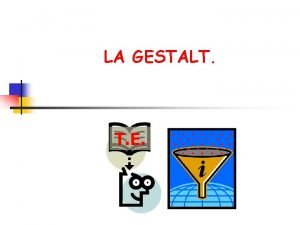Gestalt Therapy Characteristics of Gestalt Therapy u Developed


















- Slides: 18

Gestalt Therapy

Characteristics of Gestalt Therapy u Developed in the 1940 s by Frederick “Fritz” Perls and colleagues as a revision in psychoanalysis u Founded in the European philosophical climate that influenced humanistic, experiential, and existential therapies u Based on principles of holism and field or systems thinking, including the works of Kurt Goldstein (1939) and Kurt Lewin (1938), as well as Jan Smuts (1926/1996), Prime Minister of South Africa u Evolved as the first “integrative psychotherapy”

Fritz Perls u Fritz Perls received in 1924 his M. D. from Franfurt -am-Main; Laura Perls completed the D. Sc. u They were influenced by phenomenology and existentialism, gestalt psychology and field theory u Fritz Perls was trained as a psychoanalyst. He was analyzed by Wilhelm Reich, M. D. , who emphasized body awareness in psychoanalysis u Laura Perls studied with Martin Buber, acquiring the existential emphases upon immediate experience and relationship

Fritz Perls u Fritz and Laura Perls traveled from German to Holland South Africa to escape the Nazi movement u They left South Africa when aparteid policies were initiated u They came to the United States and worked with Paul Goodman and others u Perls’ first publication in 1942 was Ego, Hunger and Aggression; Gestalt Therapy was published in 1951 and led to the founding of training institutes in New York, Cleveland other cities

Fritz Perls u Upon publication of Ego, Hunger and Aggression; Gestalt Therapy, Maria Bonaparte, orthodox Freudian said, “If you don’t believe in the libido theory any more, you had better hand in your resignation” (to the orthodox group) u Served in the South African Army 1944 -1946; Admired the prime minister, Jan Smuts who emphasized the concept of ecology: “Organism-asa-whole-embedded-in-environment. This becomes the Unit (of analysis)”

Fritz Perls u Gestalt Therapy (1950 -1951) rejected by academic gestalt psychologists, but increasingly popular among psychotherapists and philosophers u Perls distanced himself from the existentialists in 1962: “Existence: a rose is a rose. The experienced phenomenon as the ultimate Gestalt!! Not religion-oriented like Buber, Tillich and Marcel; not language-oriented like Heidegger; not communist-oriented like Sartre; not psychoanalytically oriented like Binswinger”

Fritz Perls u Joined Esalen Institute in 1964; Esalen is home to the “third Force” or third wave in psychotherapy (after psychoanalysis and behavior therapy) u Perls performed with Joan Baez at the Big Sur Folk Festival "One Hand Clapping. " Esalen Institute - 1967 u Last workshop, February 1970 in Lexington, Massachustetts

Basic Concepts u Organismic self-regulation u Contact or conscious awareness u Boundary disturbance u Active experimentation u Creative adjustment u Gestalt

Clients in Gestalt Therapy u Adults u Children u Musicians, artists and creative persons u Couples and families u Groups

Process of Gestalt Therapy u Establishing Contact n Genuineness and self-disclosure of therapist n Here-and-now orientation u Cultivating Awareness n Focus on body and somatic sensations n Active exploration or experimentation u Resolving Conflicts n Enactment (e. g. , “empty chair”) n Imagery techniques and body work

Views on Psychopathology u Rejection of most systems of diagnosis u Radical ecological or field perspective in which there is no meaningful way to consider a person apart from the relational environment u Organismic self-regulation implies that people are self-regulating and motivated to solve their own problems; healthy functioning allows a person to be whole and to shift back and forth as needed between figure and ground

Views on Psychopathology u Persons connect with others to form meaningful relationships and separate from unhealthy others to promote homeostasis or balance u Psychopathology results from boundary disturbance u When coming together is blocked, the person is stuck in isolation, an unhealthy condition u When withdrawal is blocked, there is the boundary disturbance of confluence in which individual identity is lost

Views on Psychopathology u When a person tries to avoid one’s own experience and a phenomenon is attributed to another person, projection occurs u When a person fails to include or recognize the contributions of another person, focusing only on the self, then retroflection occurs u In creative adjustment, people respond naturally to the demands of their situations and form meaningful gestalts in the process u Impoverished environments and neurotic selfregulation disrupt personality functioning

Views on Psychopathology u In neurotic self-regulation, aspects of one’s ground (e. g. , unbearable loneliness) must be kept out of awareness, resulting in hardened polarities in life u Resistance emerges as a person suppresses emotion and opposes the formation of a figure (e. g. , a thought, feeling, impulse or need) u There are splits or polarities within the self and between self and others u As a split persists, experiences trigger anxiety or awareness of the polarities and dichotomies

Views on Psychopathology u Anxiety can contribute to a process of change in which a new gestalt is formed u Yet, anxiety can also result in defenses of resistance and boundary disturbance such that customary sources of support are lost u When customary supports are not available and new supports have not been formed, the person experiences an impasse u An impasse can be experienced fully and creatively resolved or the person may return to patterns of old and maladaptive behavior

Some Thoughts on Confrontation u Gestalt therapy, especially as manifested in the person of Fritz Perls, always emphasized confrontation u Confrontation was intended to force new gestalts or figure-ground relationships u Recent developments in Gestalt therapy take into account the issue of shame formation; therefore, there is less emphasis upon confrontation and other active technique that exacerbate shame (i. e. , Lee & Wheeler, 1996)

References u Buber, M. (1923/1970). I and thou (w. Kaufmann, Trans. ). New York: Scribner. u Goldstein, K. (1939/1963). The organism. Boston, MA: Beacon. u Lee, R. , & Wheeler, G. (1996). The voice of shame: Silence and connection in psychotherapy. San Francisco: Jossey-Bass. u Lewin, K. (1939). A dynamic theory of personality. London: Routledge & Kegan Paul. u Perls, F. (1942/1992). Ego, Hunger and aggression. New York: The Gestalt Journal Press.

References u Perls, F. , Hefferline, R. , & Goodman, P. (1951/1994). Gestalt therapy: Excitement and growth in the human personality. New York: The Gestalt Journal Press. u Yontef, G. , & Jacobs, L. (2005). Gestalt therapy. In R. J. Corsini & D. Wedding (Eds. ), Current psychotherapies (7 th ed. ) (pp. 299 -336). Belmont, CA: Brooks. Cole.
 Gestalt
Gestalt Peeling the onion psychology
Peeling the onion psychology Gestalt therapy empty chair
Gestalt therapy empty chair Gestalt therapy example
Gestalt therapy example A whole new approach
A whole new approach Making the rounds in gestalt therapy
Making the rounds in gestalt therapy Bariatric dental chair
Bariatric dental chair Sajjad urban dictionary
Sajjad urban dictionary Gestalt therapy goals
Gestalt therapy goals Psychodynamic and humanistic therapies have in common
Psychodynamic and humanistic therapies have in common Bioness integrated therapy system price
Bioness integrated therapy system price Psychoanalytic therapy is to as humanistic therapy is to
Psychoanalytic therapy is to as humanistic therapy is to Objective of play therapy
Objective of play therapy Developed country
Developed country Advantages of abrasive water jet machining
Advantages of abrasive water jet machining Unix was originally developed in
Unix was originally developed in Comparative education in developing countries
Comparative education in developing countries Travis hirschi theory
Travis hirschi theory What is circuit training method
What is circuit training method


